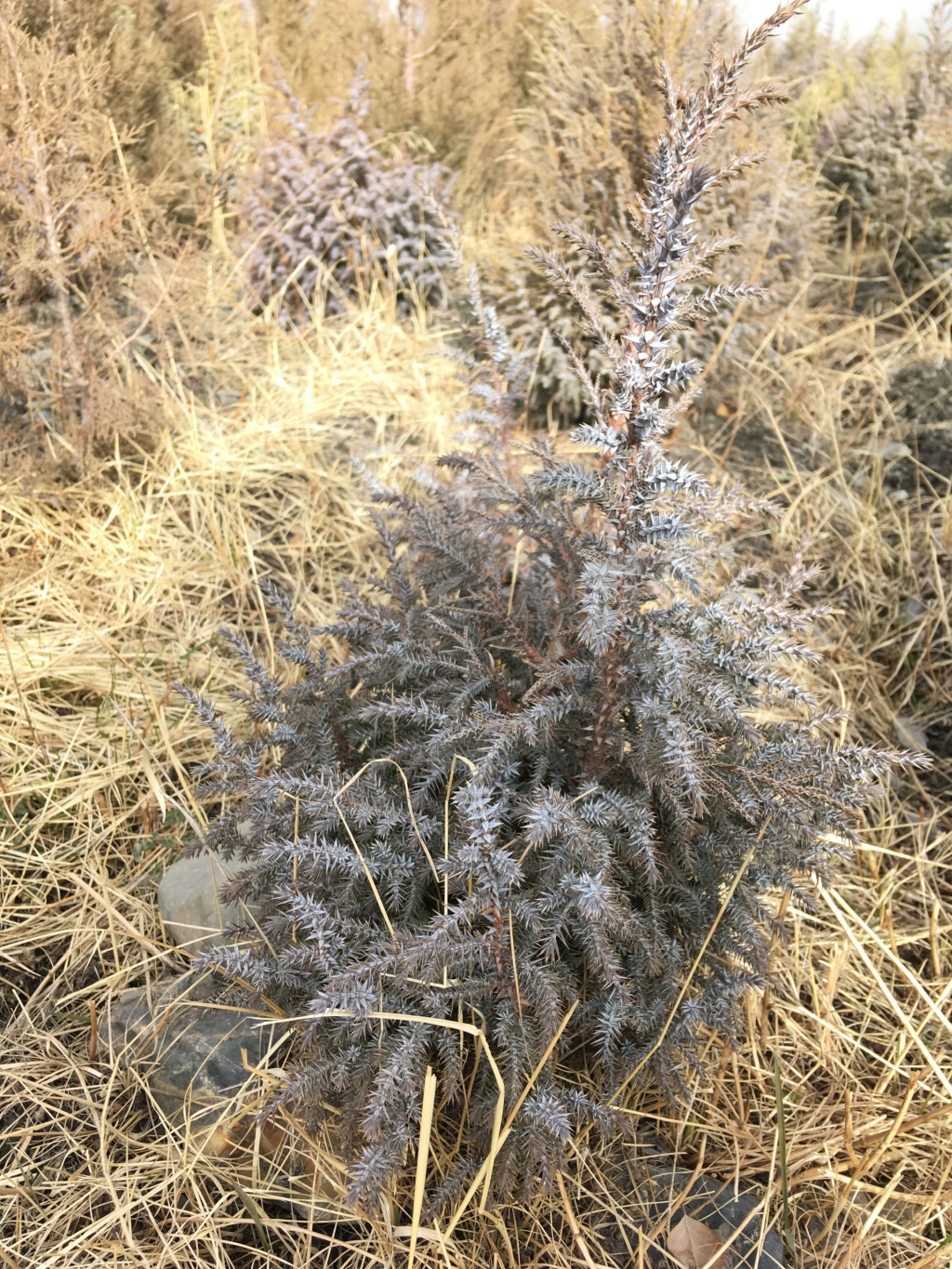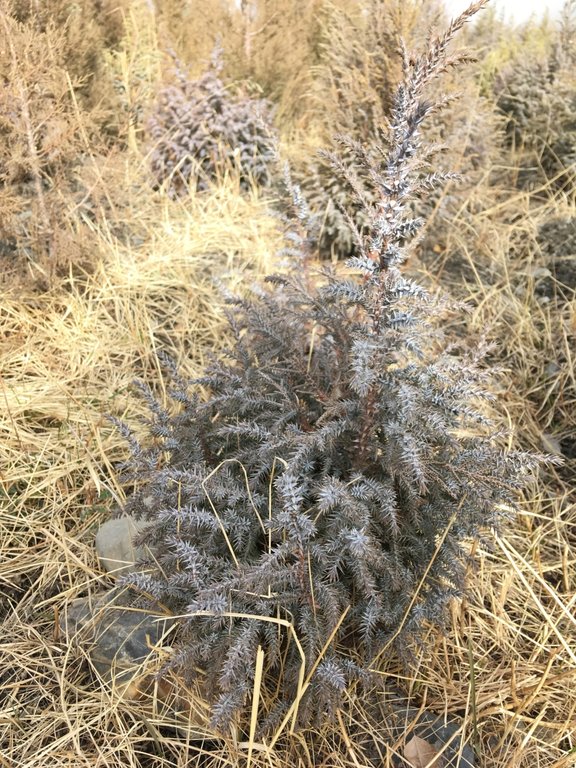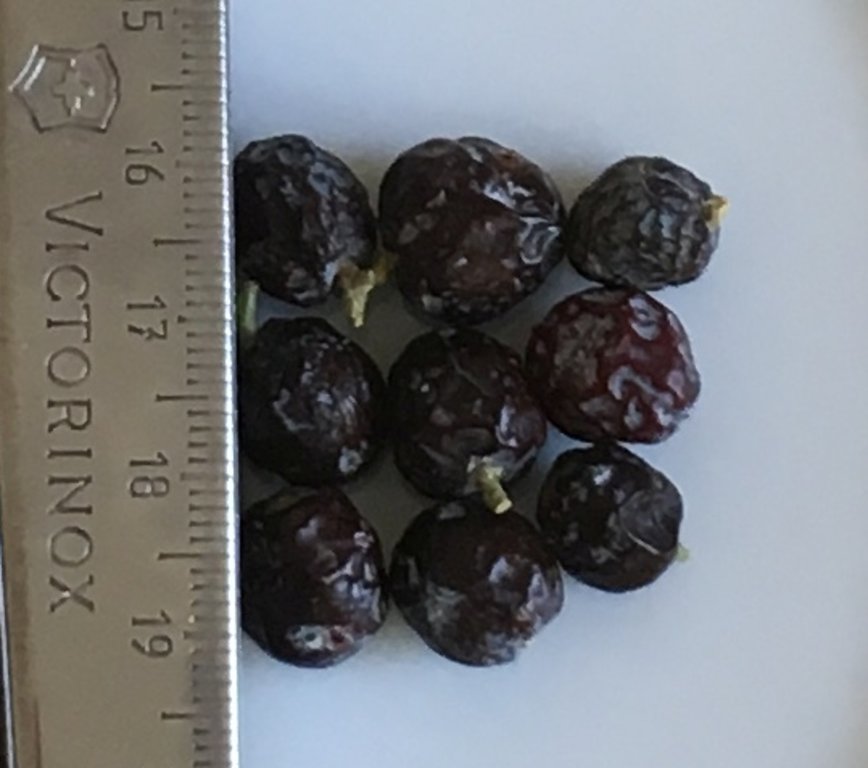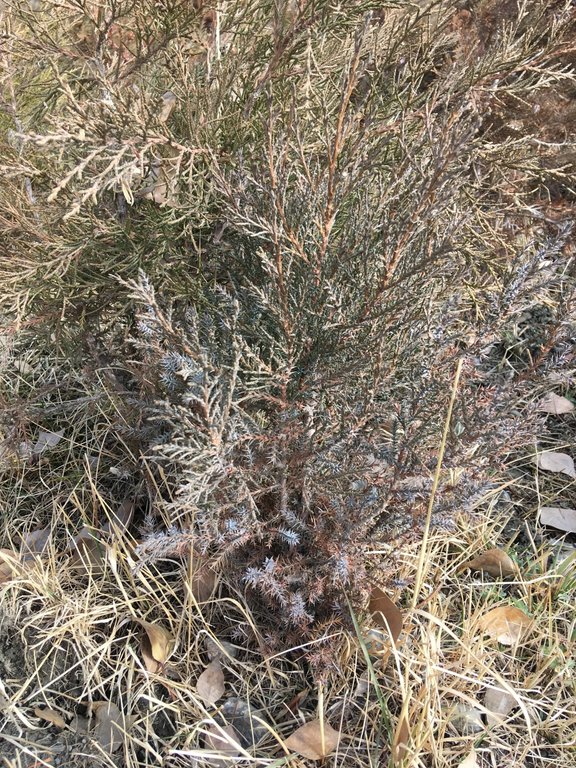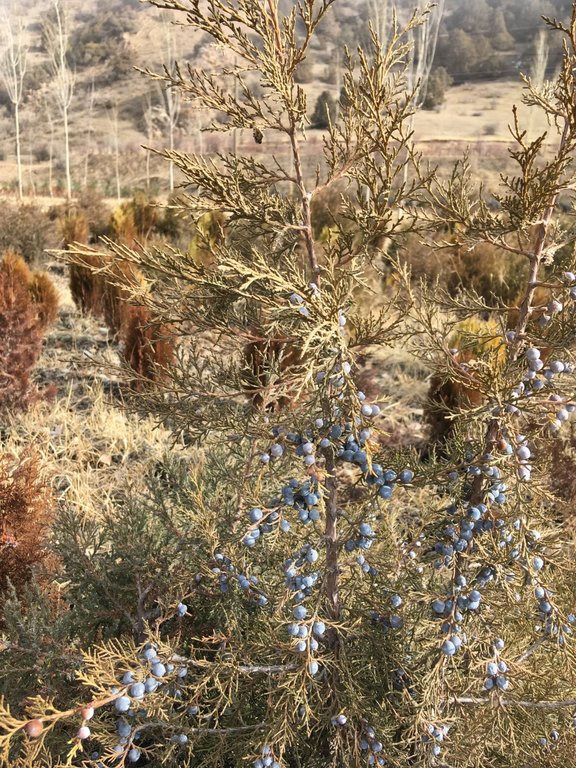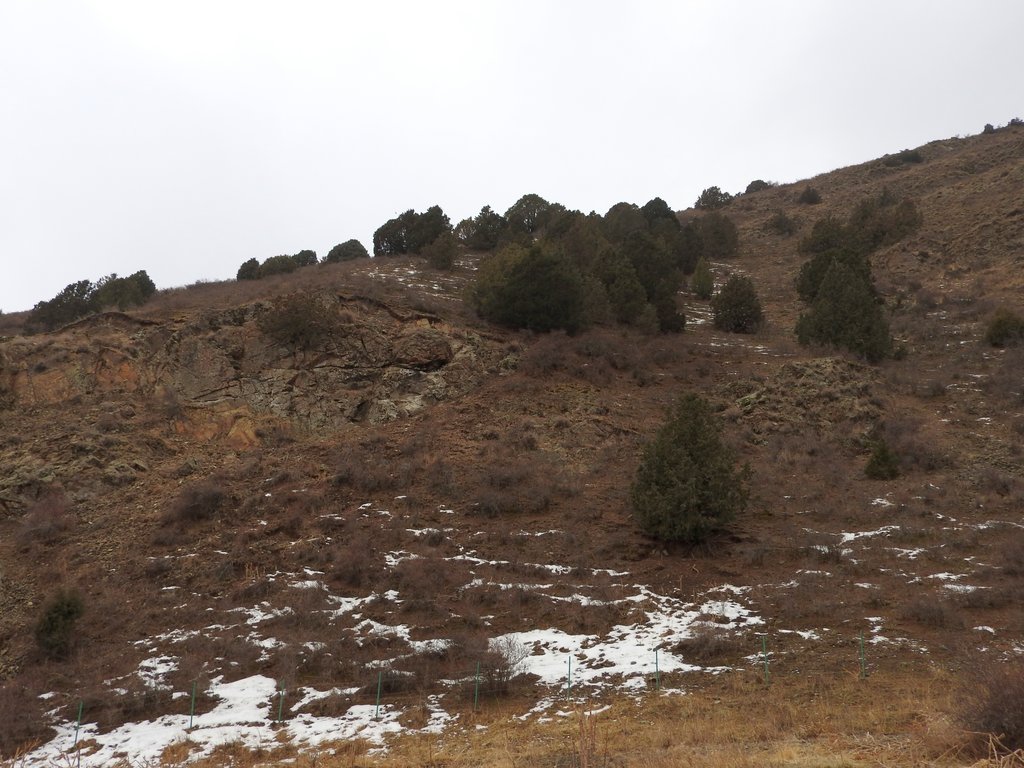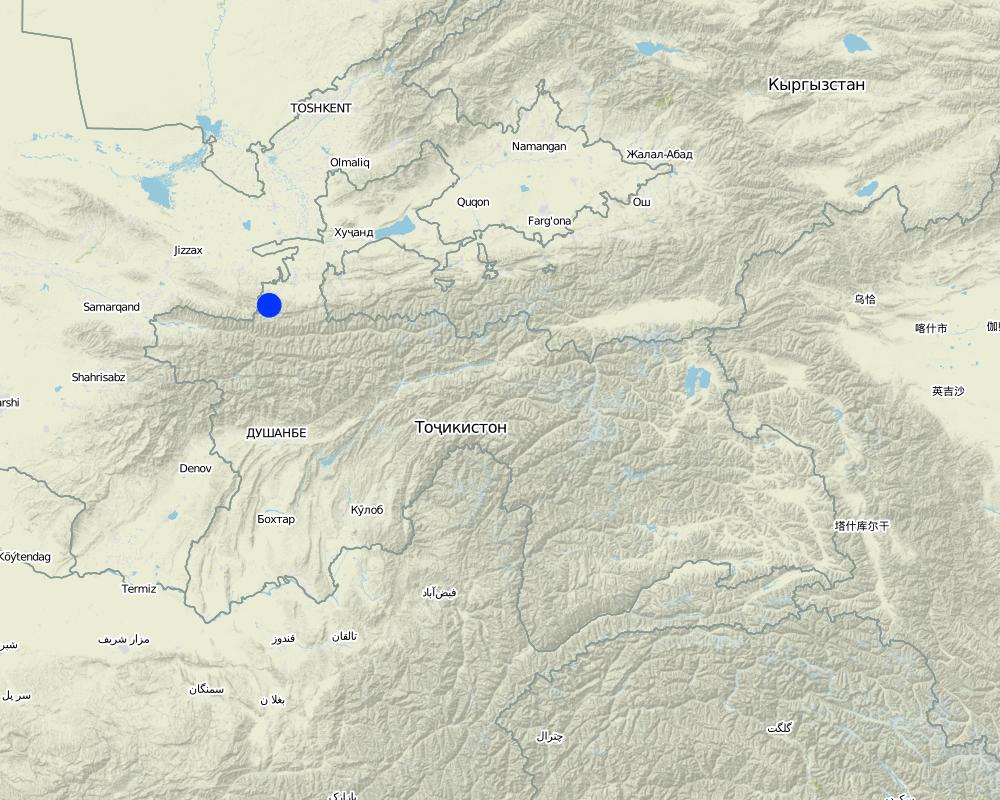Cultivation of local juniper species for rehabilitation of degrading woodland pastures [Tajiquistão]
- Criação:
- Atualização:
- Compilador/a: Stefan Michel
- Editor: –
- Revisor: Umed Vahobov
Выращивание саженцев арчы для восстановления деградирующего редколесья горных пастбищ.
technologies_4295 - Tajiquistão
Veja as seções
Expandir tudo Recolher tudo1. Informação geral
1.2 Detalhes do contato das pessoas capacitadas e instituições envolvidas na avaliação e documentação da tecnologia
Pessoa(s) capacitada(s)
usuário de terra:
Shodiev Fakhriddin
Shahriston Forestry Enterprise
Tajiquistão
Nome do projeto que facilitou a documentação/avaliação da Tecnologia (se relevante)
Strengthening of Livelihoods through Climate Change Adaptation in Kyrgyzstan and TajikistanNome da(s) instituição(ões) que facilitou(ram) a documentação/ avaliação da Tecnologia (se relevante)
GIZ Tajikistan (GIZ Tajikistan) - Tajiquistão1.3 Condições em relação ao uso da informação documentada através de WOCAT
O/a compilador/a e a(s) pessoa(s) capacitada(s) aceitam as condições relativas ao uso de dados documentados através da WOCAT:
Sim
1.4 Declaração de sustentabilidade da tecnologia descrita
A tecnologia descrita aqui é problemática em relação a degradação da terra de forma que não pode ser declarada uma tecnologia de gestão sustentável de terra?
Não
1.5 Referência ao(s) questionário(s) sobre abordagens GST (documentado(s) usando WOCAT)
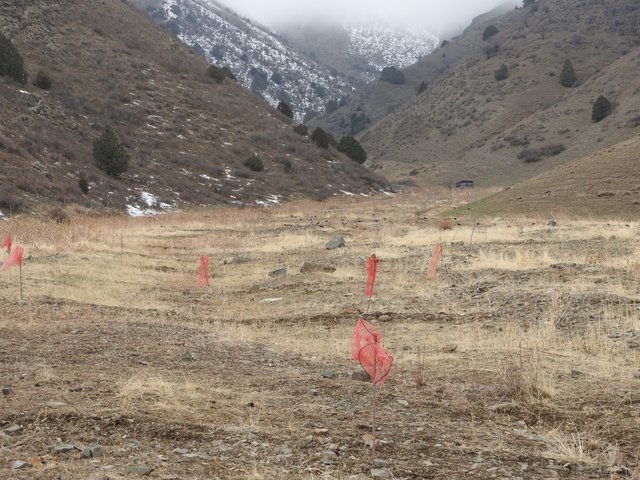
Disaster risk reduction and sustainable land-use by integrated … [Tajiquistão]
A site affected by a debris flow was rehabilitated by joint communal work and integrated preventive measures addressing the upper catchment as well as the valley and the debris conus were implemented in collaboration of community, individual farmers, Committee of Emergency Situations and forestry enterprise.
- Compilador/a: Stefan Michel
2. Descrição da tecnologia de GST
2.1 Descrição curta da tecnologia
Definição da tecnologia:
The local species of juniper trees (Juniperus seravschanica, Juniperus turkestanica and Juniperus semiglobosa) are rarely rejuvenating under conditions of intensive grazing and are difficult to propagate in nurseries. The technology describes the propagation of these important trees from locally collected seeds and their cultivation.
2.2 Descrição detalhada da tecnologia
Descrição:
The technology is used to produce seedlings of juniper trees in the forestry nursery for further replanting in the natural juniper woodlands of the local forestry enterprise. Juniper woodlands are important ecosystems of the mountains of Central Asia, which are typically used for livestock grazing. The tree cover fulfills important functions for the maintenance of ecosystem services – local microclimate, regulation of water infiltration and surface runoff, biodiversity, esthetic value and recreation, fuelwood etc. The local juniper species rarely rejuvenate naturally. Factors hampering natural rejuvenation include intensive grazing, competition by other plant species and weather conditions. Loss of old juniper trees due to natural losses, damage and cutting combined with lacking rejuvenation causes the degradation and loss of juniper stands. Forestry enterprises in Central Asia often in such situations instead of the difficult to cultivate and slowly growing native juniper often plant non-native arborvitae Thuja spec. These non-native species do not provide the natural ecosystem functions of native juniper and are less adapted to the local site conditions.
The purpose of the described technology is therefore the provision of planting material for the rehabilitation of degraded juniper woodland pastures with native trees.
Forestry workers collect ripe juniper fruits from their natural stands during late fall (November – December). The fruits are than mixed with sand and stored in a cold place until spring, or they are further processed to accelerate germination.
In the first case in spring the fruits are crushed on a clean concrete surface either by trampling with boots or by using a vehicle. Afterwards the crushed fruits are washed and air-dried. With the help of wind and a sieve the dried seeds are cleaned from other parts of the fruits. The seeds are then stored under a 5 cm layer of sand until fall and sown in fall (October-November)
In the second case the fruits are initially for one month stored in a barrel with water. Then the fruits are crushed and cleaned as described above. The cleaned seeding material will be stored in a pit, covered with moist sand mixed with some dung from horses or cattle. After one month the seeds are sown into the nursery.
In the area of the forestry enterprise brown bears feed on juniper fruits. In the bear feces many juniper seeds can be found, sometimes directly germinating. This “natural stratification” is sometimes used by forestry workers if they find substantial amounts of bear feces consisting of juniper fruits.
The seeds are sown directly into the soil in the nursery. Each, germination rate and survival are 90%. After five years the seedlings have grown to a height of about 20-30 cm, their roots reach 20 cm deep into the soil and they are ready for replanting.
The seedlings are carefully dug out, deep enough not to damage the root system and together with the earth covering the roots. They are wrapped in plastic bags for keeping the earth cover of the roots during transportation. During the planting the seedlings are put into the tree pits together with the soil from the nursery still covering the root system. The planted seedlings are watered.
After planting the seedlings are five years cared for, including weeding and if necessary watering either from a canal, if available, or with barrels.
The use of containers for seeding and replanting has not yet been tried. It may protect the root system during replanting and reduce the amount of soil to be used for this purpose. On the other hand the technology without containers is not dependent on their availability, no garbage in form of plastic containers is left in the tree pits and the larger amount of soil from the nursery may ease establishment of the seedlings at the woodland rehabilitation site.
2.3 Fotos da tecnologia
2.5 País/região/locais onde a tecnologia foi aplicada e que estão cobertos nesta avaliação
País:
Tajiquistão
Região/Estado/Província:
Sughd
Especificação adicional de localização:
Shahriston district; Shahriston Forestry Enterprise
Especifique a difusão da tecnologia:
- Aplicado em pontos específicos/concentrado numa pequena área
O(s) local(is) tecnológico(s) está(ão) localizado(s) em uma área permanentemente protegida?
Não
Comentários:
The approximate locatoion of the nursery is indicated. The planting of produced seedlings takes place in different areas.
Map
×2.6 Data da implementação
Caso o ano exato seja desconhecido, indique a data aproximada:
- 10-50 anos atrás
2.7 Introdução da tecnologia
Especifique como a tecnologia foi introduzida:
- atráves de inovação dos usuários da terra
Comentários (tipos de projeto, etc.):
The technology is implemented by Shahriston Forestry Enterprises since several decades.
3. Classificação da tecnologia de GST
3.1 Principal/principais finalidade(s) da tecnologia
- Reduz, previne, recupera a degradação do solo
- Preserva ecossistema
- Preservar/melhorar a biodiversidade
- Adaptar a mudanças climáticas/extremos e seus impactos
- Cria impacto social benéfico
3.2 Tipo(s) atualizado(s) de uso da terra onde a tecnologia foi aplicada
Uso do solo misturado dentro da mesma unidade de terra:
Sim
Especificar o uso misto da terra (culturas/ pastoreio/ árvores):
- Silvipecuária

Pastagem
Pastagem extensiva:
- Pastoralismo semi-nômade
- Pastoreio transumante
Tipo de animal:
- gado - lácteo
- gado - carne bovina não-láctea
- caprinos
- cavalos
- ovelhas
Produtos e serviços:
- carne

Floresta/bosques
- Florestas/bosques (semi)naturais
Florestas (semi)naturais/ bosques: Especificar o tipo de manejo:
- Retirada de madeira morta/podas
- Uso florestal não madeireiro
Tipo de floresta (semi)natural:
- vegetação natural de sistemas montanhosos temperados
As árvores especificadas acima são decíduas ou perenes?
- decíduas mistas/perene
Produtos e serviços:
- Lenha
- Outros produtos florestais
- Pastagem/Alimentação de folhas e brotos
- Conservação/proteção da natureza
- Lazer/turismo
- Proteção contra desastres naturais
3.3 O uso do solo mudou devido à implementação da Tecnologia?
O uso do solo mudou devido à implementação da Tecnologia?
- Não (Continuar com a pergunta 3.4)
3.5 Grupo de GST ao qual pertence a tecnologia
- Gestão natural e seminatural de floresta
- Gestão de pastoralismo e pastagem
3.6 Medidas de GST contendo a tecnologia

Medidas vegetativas
- V1: cobertura de árvores/arbustos

Medidas de gestão
3.7 Principais tipos de degradação da terra abordados pela tecnologia

Erosão do solo pela água

Degradação biológica
- Bc: redução da cobertura vegetal
- Bh: perda dos habitats
- Bq: quantidade/ declínio da biomassa
- Bs: Qualidade e composição de espécies/declínio de diversidade
3.8 Redução, prevenção ou recuperação da degradação do solo
Especifique o objetivo da tecnologia em relação a degradação da terra:
- Prevenir degradação do solo
- Reduzir a degradação do solo
4. Especificações técnicas, implementação de atividades, entradas e custos
4.3 Atividades de implantação
| Atividade | Periodicidade (estação do ano) | |
|---|---|---|
| 1. | Collection of fruits from natural juniper stands | November-December |
| 2. | Stratification, cleaning of seeds | Winter - spring |
| 3. | Seeding | Winter or October-November |
| 4. | Replanting | Fall, five years after seeding |
| 5. | Watering, weeding | Each summer, up to five years |
Comentários:
Watering not always needed and/or possible. Often only once watered during first summer after replanting.
4.4 Custos e entradas necessárias para a implantação
Comentários:
The technology is implemented in the frame of the regular activities of the state forestry enterprise. No calculation of costs was available during the time of the documentation.
4.5 Atividades recorrentes/manutenção
Comentários:
All maintenance activities (weeding, watering) are above indicated as establishment activities. After the planted juniper are established no further maintenance is required.
5. Ambiente natural e humano
5.1 Clima
Precipitação pluviométrica anual
- <250 mm
- 251-500 mm
- 501-750 mm
- 751-1.000 mm
- 1.001-1.500 mm
- 1.501-2.000 mm
- 2.001-3.000 mm
- 3.001-4.000 mm
- > 4.000 mm
Especificações/comentários sobre a pluviosidade:
Rainfall is highly variable depending on altitude and aspect.
Indique o nome da estação meteorológica de referência considerada:
Shahriston (https://en.climate-data.org/asia/tajikistan/sughd-province/shahriston-28044/)
Zona agroclimática
- Subúmido
- Semiárido
Climate depends in altitude and aspect. At higher elevation and northern (eastern and western) aspect climate tends towards subhumid.
5.2 Topografia
Declividade média:
- Plano (0-2%)
- Suave ondulado (3-5%)
- Ondulado (6-10%)
- Moderadamente ondulado (11-15%)
- Forte ondulado (16-30%)
- Montanhoso (31-60%)
- Escarpado (>60%)
Formas de relevo:
- Planalto/planície
- Cumes
- Encosta de serra
- Encosta de morro
- Sopés
- Fundos de vale
Zona de altitude:
- 0-100 m s.n.m.
- 101-500 m s.n.m.
- 501-1.000 m s.n.m.
- 1.001-1.500 m s.n.m.
- 1.501-2.000 m s.n.m.
- 2.001-2.500 m s.n.m.
- 2.501-3.000 m s.n.m.
- 3.001-4.000 m s.n.m.
- > 4.000 m s.n.m.
Indique se a tecnologia é aplicada especificamente em:
- Não relevante
Comentários e outras especificações sobre a topografia:
Nursery at terrace of valley, woodlands at mountain slopes of varying steepness and altitudinal zones.
5.3 Solos
Profundidade do solo em média:
- Muito raso (0-20 cm)
- Raso (21-50 cm)
- Moderadamente profundo (51-80 cm)
- Profundo (81-120 cm)
- Muito profundo (>120 cm)
Textura do solo (solo superficial):
- Grosso/fino (arenoso)
- Médio (limoso, siltoso)
Matéria orgânica do solo superficial:
- Alto (>3%)
- Médio (1-3%)
Caso disponível anexe a descrição completa do solo ou especifique as informações disponíveis, p. ex. tipo de solo, PH/acidez do solo, nitrogênio, capacidade de troca catiônica, salinidade, etc.
Soil at nursery site may differ from conditions at the actual woodlands. Soil conditions in juniper woodlands can be very diverse.
5.4 Disponibilidade e qualidade de água
Lençol freático:
5-50 m
Disponibilidade de água de superfície:
Médio
A salinidade da água é um problema?
Não
Ocorre inundação da área?
Não
Comentários e outras especificações sobre a qualidade e a quantidade da água:
Juniper typically grows in areas without ground water influence, but locally and where deforestation has not impacted the stands too much, juniper can also grow in riparian areas outside of the immediate influence of the river and subsoil water.
5.5 Biodiversidade
Diversidade de espécies:
- Médio
Diversidade de habitat:
- Médio
Comentários e outras especificações sobre biodiversidade:
Biodiversity in juniper woodlands varies depending on the specific type of vegetation and use intensity.
5.6 Características dos usuários da terra que utilizam a tecnologia
Indique outras características relevantes dos usuários da terra:
The land-user applying the technology is the state forestry enterprise.
5.7 Área média de terrenos utilizados pelos usuários de terrenos que aplicam a Tecnologia
- < 0,5 ha
- 0,5-1 ha
- 1-2 ha
- 2-5 ha
- 5-15 ha
- 15-50 ha
- 50-100 ha
- 100-500 ha
- 500-1.000 ha
- 1.000-10.000 ha
- > 10.000 ha
É considerado pequena, média ou grande escala (referente ao contexto local)?
- Pequena escala
Comentários:
Nursery is only few hectares. Woodland rehabilitation takes place in areas of several ten hectares each. The overall area belonging to the land use (forestry enterprise) is >10,000 ha.
5.8 Propriedade de terra, direitos de uso da terra e de uso da água
Propriedade da terra:
- Estado
Direitos do uso da terra:
- Arrendado
Os direitos de uso da terra são baseados em um sistema jurídico tradicional?
Não
Comentários:
The forestry enterprise issues permits for seasonal use of juniper woodlands for livestock grazing by associations or individual livestock herders.
5.9 Acesso a serviços e infraestrutura
Comentários:
Not relevant for this technology.
6. Impactos e declarações finais
6.1 Impactos no local mostrados pela tecnologia
Impactos socioeconômicos
Disponibilidade e qualidade de água
Disponibilidade de água para irrigação
Impactos socioculturais
Oportunidades de lazer
Impactos ecológicos
Ciclo hídrico/escoamento
Quantidade de água
Colheita/recolhimento de água
Escoamento superficial
Evaporação
Solo
Umidade do solo
Cobertura do solo
Perda de solo
Matéria orgânica do solo/carbono abaixo do solo
Biodiversidade: vegetação, animais
Cobertura vegetal
Biomassa/carbono acima do solo
Diversidade vegetal
Diversidade animal
Diversidade de habitat
Clima e redução de riscos de desastre
Deslizamentos de terra/fluxos de escombros
Microclima
Especificar a avaliação dos impactos no local (medidas):
There are no scientific assessments of on-site impacts available. The assesment here represents a rough guess of impact of juniper woodland rehabilitation in moderately degraded pasture areas.
6.2 Impactos externos mostrados pela tecnologia
Disponibilidade de água
Caudal confiável e estável em período seco
Cheias de jusante
Sedimentação a jusante
Danos em áreas vizinhas
Danos na infraestrutura pública/privada
Especificar a avaliação dos impactos fora do local (medidas):
There are no scientific assessments of on-site impacts available. The assesment here represents a rough guess of impact of juniper woodland rehabilitation in moderately degraded pasture areas.
6.3 Exposição e sensibilidade da tecnologia às mudanças climáticas graduais e extremos/desastres relacionados ao clima (conforme o ponto de vista dos usuários da terra)
Mudança climática gradual
Mudança climática gradual
| Estação do ano | aumento ou diminuição | Como a tecnologia lida com isso? | |
|---|---|---|---|
| Temperatura anual | aumento | moderadamente | |
| Temperatura sazonal | estação seca | aumento | moderadamente |
| Precipitação pluviométrica anual | redução/diminuição | moderadamente | |
| Precipitação pluviométrica sazonal | estação úmida/das chuvas | redução/diminuição | moderadamente |
| Precipitação pluviométrica sazonal | estação seca | redução/diminuição | moderadamente |
Comentários:
Juniper trees grow at sites with a broad range of climate conditions, some of them rather extreme. They can therefore expected to cope with increasing aridity and short-term extremes at their natural stands. In the nursery drought can be compensated by watering, although intensive watering may hamper adaptability and survival of replanted saplings.
6.4 Análise do custo-benefício
Como os benefícios se comparam aos custos de implantação (do ponto de vista dos usuários da terra)?
Retornos a curto prazo:
neutro/balanceado
Retornos a longo prazo:
levemente positivo
Como os benefícios se comparam aos custos recorrentes/de manutenção(do ponto de vista dos usuários da terra)?
Retornos a curto prazo:
levemente positivo
Retornos a longo prazo:
positivo
Comentários:
Rehabilitation of juniper woodlands provides only long-term economic benefits. Costs of cultivation in nurseries are partly compensated by combined growing of decorative coniferous treees (thuja, spruce) for commercial sale.
6.5 Adoção da tecnologia
- casos isolados/experimental
6.6 Adaptação
A tecnologia foi recentemente modificada para adaptar-se as condições variáveis?
Não
6.7 Pontos fortes/vantagens/oportunidades da tecnologia
| Pontos fortes/vantagens/oportunidades na visão do usuário da terra |
|---|
| The technology is well established for the propagation of native juniper saplings and for the rehabilitation of juniper woodlands. |
| The technology has the advantage of allowing for the establishment/rehabilitation of tree stands with native species, which are adapted to local site conditions and are an integral component of the ecosystem. |
| The area of juniper woodlands in various stages of degradation in the country makes up many ten thousands of hectares. While resources (labour, nursery capacity) are prohibitive for replanting juniper in all areas, the technology allows for rehabilitation of key areas, identified by need and/or rehabilitation potential. In particular other forestry enterprises in the country with juniper woodlands could potentially adopt the technology. |
| Pontos fortes/vantagens/oportunidades na visão do/a compilador/a ou de outra pessoa capacitada |
|---|
| Same as land user's view. |
| Same as land user's view. |
| Same as land user's view. |
6.8 Pontos fracos, desvantagens/riscos da tecnologia e formas de superá-los
| Pontos fracos/desvantagens/riscos na visão do usuário da terra | Como eles podem ser superados? |
|---|---|
| Substantial amount of work required. | Nothing suggested. |
| Juniper grows slower than other species. | Nothing suggested. |
| None mentioned |
| Pontos fracos/vantagens/riscos na visão do/a compilador/a ou de outra pessoa capacitada | Como eles podem ser superados? |
|---|---|
| Same as land user's view. | Consider facilitation of natural rejuvenation through grazing management (temporary exclusion of sites or reduction of grazing intensity or adaptation of herd compostion - no goats). |
| Same as land user's view. | Natutral feature of the native juniper tree species, which cannot be changed, but needs to be taken into consideration during production of planting material and in the management of the woodlands. |
| Over grazing may hamper success of woodland recovery. | Support establishment of replanted saplings through grazing management (temporary exclusion of sites or reduction of grazing intensity or adaptation of herd compostion - no goats). |
7. Referências e links
7.1 Métodos/fontes de informação
- visitas de campo, pesquisas de campo
Site visit at nursery (November 2018), many site visits in juniper woodlands of Tajikistan and adjacent countries since 1993.
- entrevistas com usuários de terras
Interview with forest protection engineer of Shahriston Forestry Enterprise
- entrevistas com especialistas em GST
Interview with forest protection engineer of Shahriston Forestry Enterprise, with GIZ experts Negmatjon Negmatov (agricultural expert) and Nodir Muhidinov (DRR expert).
- compilação de relatórios e outra documentação existente
Quando os dados foram compilados (no campo)?
27/11/2018
7.4 Comentários gerais
The documentation of the technology is based on the site visit at the nursery and one single interview with the forest protection engineer of Shahriston Forestry Enterprise. It was not possible to observe the entire process of propagation, cultivation and replanting of juniper and to verify the recieved information. The compiler took into consideration additionally his ecological knowledge and expertise. Given the importance of juniper woodlands as ecosystems in Central Asia, their large-scale degradation, the difficulties of their rehabilitation and the prevalence of non-native species in reforestation projects this technology deserves documentation and further consideration.
Links e módulos
Expandir tudo Recolher tudoLinks

Disaster risk reduction and sustainable land-use by integrated … [Tajiquistão]
A site affected by a debris flow was rehabilitated by joint communal work and integrated preventive measures addressing the upper catchment as well as the valley and the debris conus were implemented in collaboration of community, individual farmers, Committee of Emergency Situations and forestry enterprise.
- Compilador/a: Stefan Michel
Módulos
Não há módulos


